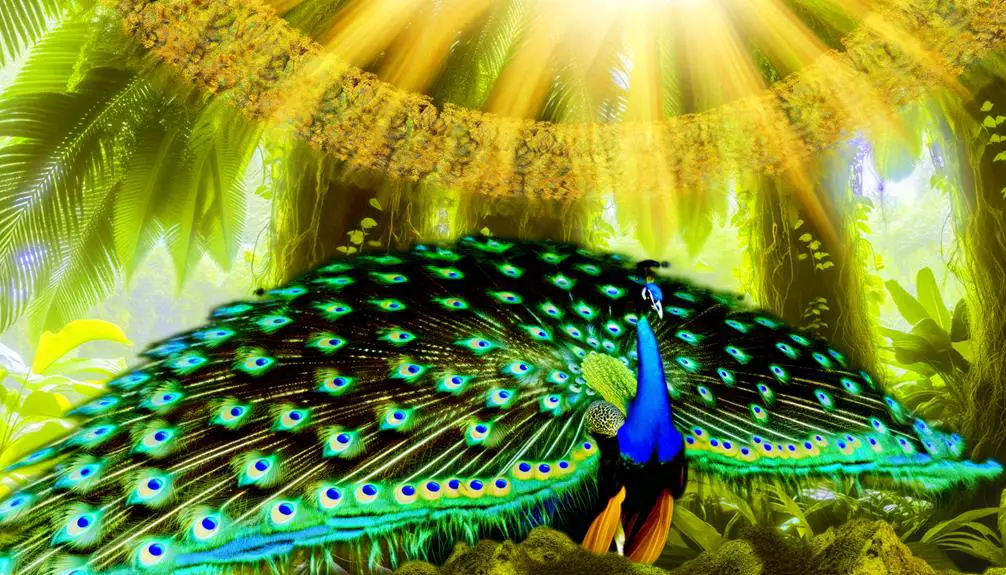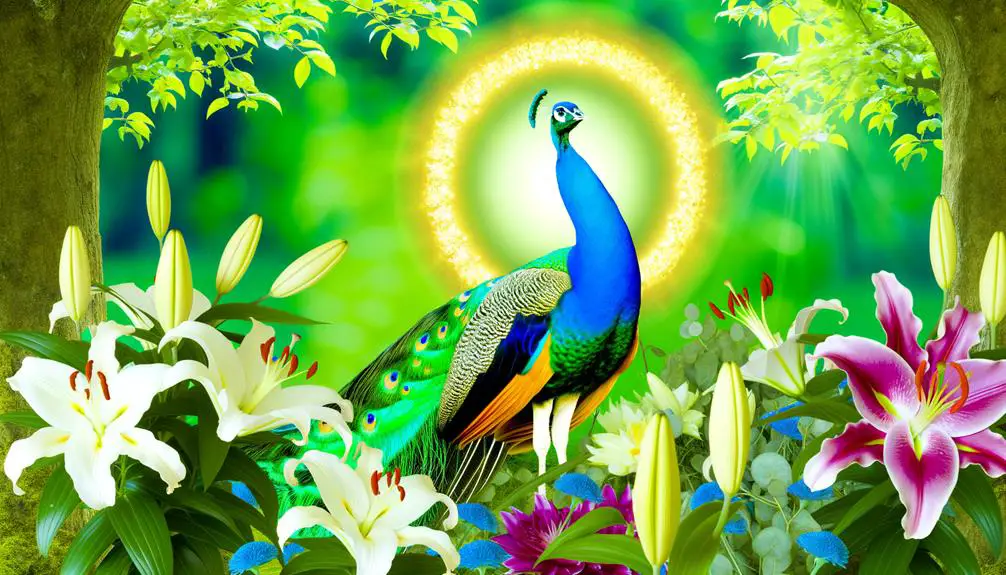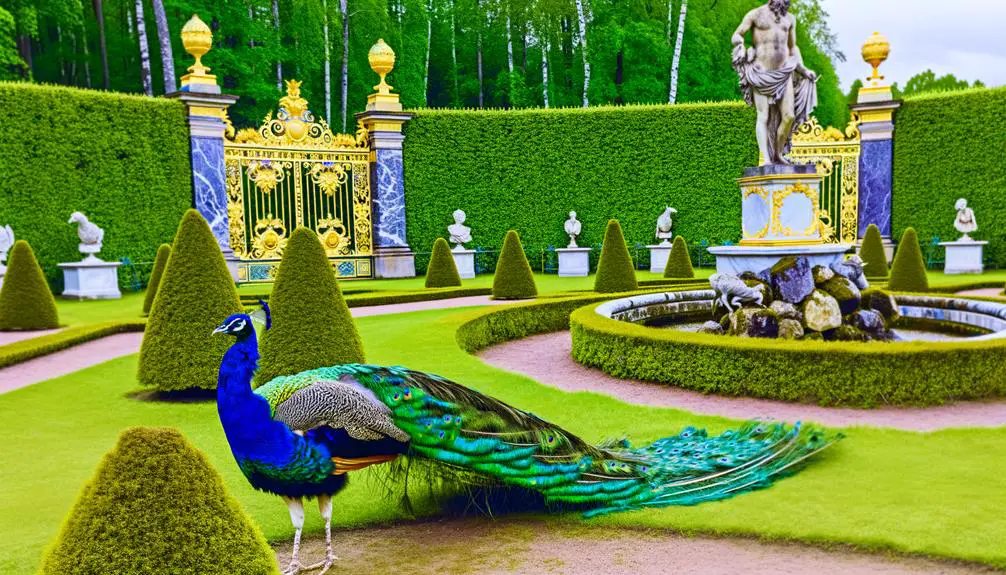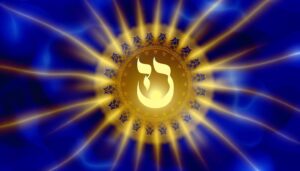Interpreting the Peacock as a Symbol of Beauty and Elegance
The peacock symbolizes immortality and resurrection, reflecting its vibrant plumage regeneration. It epitomizes beauty and pride through its elaborate courtship displays.
Historically, it signifies royalty and nobility, evidenced by usage in Persian and Indian palaces. Spiritually, it represents divinity, wisdom, and eternal life in Hinduism, Christianity, and Buddhism.
The peacock also embodies protection, as seen in its association with deities like Kartikeya and Hera. Culturally, its lifecycle of shedding and regrowth metaphorically illustrates renewal and transformation.
To uncover more nuanced insights into these symbolic interpretations, an exploration of cultural and historical contexts is essential.

Key Takeaways
- Immortality and Resurrection: The peacock symbolizes immortality and resurrection in various mythologies and religions.
- Beauty and Pride: The peacock's vibrant plumage signifies beauty and pride, essential in courtship displays.
- Royalty and Nobility: Historically, peacocks represent royalty and nobility, adorning palaces and heraldic symbols.
- Spirituality and Divinity: In many religions, the peacock embodies spirituality, wisdom, and divine protection.
- Protection and Guardianship: The peacock is seen as a symbol of protection and guardianship in multiple cultural traditions.
Immortality and Resurrection

The peacock has long been associated with immortality and resurrection in various mythologies and cultural traditions, owing to its ability to regenerate its vibrant plumage annually.
In ancient Greek mythology, the bird was linked to Hera, the goddess of marriage and childbirth, symbolizing renewal and eternal life.
Similarly, in Hinduism, the peacock is connected to the deity Saraswati, embodying cyclical regeneration. The periodic molting and regrowth of its feathers serve as a natural metaphor for continual renewal.
Scientific observations confirm that the peacock undergoes a regular molting process, shedding old feathers and growing new ones, which perpetuates its striking appearance. This biological phenomenon underpins its symbolic representation as an emblem of enduring essentiality and cyclic rebirth.
Beauty and Pride
The peacock's vibrant feather display, characterized by iridescent hues and intricate patterns, serves as a definitive marker of beauty and pride.
This elaborate plumage plays an important role in their majestic courtship rituals, where males exhibit their feathers to attract mates.
Additionally, the peacock holds cultural significance worldwide, often symbolizing elegance and self-esteem in various traditions and artworks.
Vibrant Feather Display
Peacocks are renowned for their vibrant feather display, which serves as a striking manifestation of both beauty and pride in the animal kingdom. The iridescent plumage of the male peacock, or peafowl, consists of elongated upper tail coverts that support eye-spotted 'ocelli' feathers.
This display is not only visually stunning but also scientifically significant for several reasons:
- Visual Spectrum: The feathers exhibit structural coloration, reflecting light to create iridescent hues.
- Symmetry: The elaborate and symmetrical arrangement of the feathers indicates genetic fitness.
- Chemical Composition: Pigments such as melanin and carotenoids contribute to the rich coloration.
These factors collectively underscore the peacock's role as an emblem of aesthetic magnificence and a demonstration of evolutionary biology.
Majestic Courtship Rituals
Beyond their vibrant feather display, male peafowl engage in majestic courtship rituals that further exemplify their beauty and pride. These rituals involve elaborate dances where the male fans out his iridescent tail feathers to their full span, creating a visually striking semicircle.
The peacock then engages in precise movements, such as shivering his feathers and producing low-frequency sounds, to capture the attention of potential mates. This display is not merely ornamental but serves as an indicator of genetic fitness and health. The symmetry, colorfulness, and quality of the plumage are key factors influencing female choice, suggesting an evolutionary advantage.
Consequently, these courtship behaviors underscore the peacock's symbolism of beauty and pride, rooted in biological imperatives for reproduction.
Cultural Significance Worldwide
Across various cultures worldwide, the peacock has long been revered as an emblem of beauty and pride, symbolizing not only aesthetic splendor but also deeper values of integrity and nobility. This symbolism is particularly evident in several cultural contexts:
- Hindu Tradition: The peacock is associated with the deity Saraswati, representing wisdom and the arts.
- Buddhism: In Buddhist iconography, peacocks symbolize compassion and mindfulness due to their serene beauty.
- Western Culture: The peacock is often linked to royalty and opulence, signifying grandeur and elegance.
These cultural references to the peacock underscore its universal appeal and multifaceted significance, reflecting a collective admiration for its striking appearance and the virtues it embodies.
Royalty and Nobility

Throughout history, the peacock has consistently served as an emblem of royalty and nobility, its resplendent plumage symbolizing opulence and grandeur. In ancient civilizations, including Persia and India, monarchs adorned their palaces with peacock motifs to signify their supreme status. The bird's iridescent feathers were often utilized in royal garments and ceremonial attire, reflecting wealth and power.
In European heraldry, the peacock was featured in coats of arms to denote nobility and aristocratic lineage. The association with royalty is also evident in the peacock throne of Mughal Emperor Shah Jahan, an artifact embodying regal splendor. Scientific studies suggest that the peacock's vibrant tail feathers result from microscopic structures that manipulate light, further enhancing its majestic appeal.
Spirituality and Divinity
In addition to its association with royalty, the peacock holds significant spiritual and divine symbolism across various cultures and religions. This majestic bird often represents:
- Rebirth and Immortality: In Hinduism, the peacock is linked to the deity Saraswati and symbolizes the cycle of life and renewal.
- Divine Protection: In Christianity, peacocks are associated with Christ's resurrection, signifying eternal life and spiritual guardianship.
- Wisdom and Vision: In Buddhism, the peacock embodies clarity of mind and insightful vision, reflecting the ability to perceive truth beyond appearances.
These associations highlight the peacock's role in conveying profound metaphysical concepts, emphasizing its importance beyond mere aesthetics.
Through these lenses, the peacock serves as a bridge between the earthly and the divine, enriching spiritual narratives.
Protection and Guardianship

The peacock's role as a symbol of protection and guardianship is deeply rooted in various cultural mythologies and religious doctrines, where it is often depicted as a vigilant guardian against negative forces and evil spirits. In Hindu mythology, the peacock is associated with the deity Kartikeya, who uses the bird as a mount, symbolizing its protective attributes. Similarly, in Greek mythology, Hera's sacred peacock, with its watchful eyes, symbolizes vigilance and protection. This symbolism is further supported by early Christian beliefs, where the peacock's incorruptible flesh was seen as a safeguard against evil.
| Culture/Religion | Symbolic Role | Deity/Entity |
|---|---|---|
| Hinduism | Guardian, Protector | Kartikeya |
| Greek Mythology | Vigilant Protector | Hera |
| Christianity | Safeguard Against Evil | Early Christian Belief |
| Buddhism | Defender | Bodhisattva Avalokiteshvara |
| Persian Mythology | Protector | Simurgh |
Renewal and Transformation
The peacock's cyclical process of shedding and regrowing its feathers serves as a powerful natural illustration of renewal and transformation.
This biological phenomenon, coupled with the bird's vibrant plumage, has been imbued with symbolic significance across various cultures, often representing rejuvenation and the cyclical nature of life.
Examining these aspects provides a thorough understanding of the peacock's role as a symbol of perpetual renewal.
Shedding and Regrowth Cycle
Peacocks exhibit a remarkable shedding and regrowth cycle, characterized by the annual molting of their extravagant tail feathers, which symbolizes renewal and transformation. This cyclical process involves several critical stages:
- Molting Phase: Annually, peacocks shed their long, iridescent tail feathers, a process driven by hormonal changes. This occurs post-breeding season, allowing the bird to conserve energy.
- Regrowth Phase: Following the molt, new feathers begin to develop. These feathers emerge from follicles and gradually gain length and vibrancy.
- Completion: The full regrowth of the tail feathers spans several months, culminating in a restored, elaborate plumage by the next breeding season.
This cycle underscores the peacock's biological adaptation and resilience, embodying a natural metaphor for renewal and transformation.
Symbolic Cultural Significance
Beyond their biological cycles, the peacock's shedding and regrowth of tail feathers holds profound symbolic cultural significance, representing themes of renewal and transformation across various traditions and mythologies.
In Hinduism, the peacock is associated with the deity Kartikeya, symbolizing immortality and cyclical renewal.
Similarly, in Greek mythology, the bird is linked to Hera, embodying resurrection and eternal life.
This avian phenomenon is also emblematic in Christianity, where the peacock signifies resurrection and the divine.
The periodic loss and regrowth of feathers serve as a poignant metaphor for life's continual process of death and rebirth.
This symbolism transcends mere aesthetic admiration, offering a rich tapestry of meanings that enhance cultural narratives and spiritual beliefs globally.
Conclusion
The peacock symbolizes various concepts such as immortality, resurrection, beauty, pride, royalty, nobility, spirituality, divinity, protection, guardianship, renewal, and transformation. This symbolism transcends cultural and temporal boundaries, highlighting its significance in different societies. Some may view these symbolisms as folklore, but the consistent reverence for the peacock underlines its profound impact. Understanding these attributes can lead to a deeper appreciation of the peacock's emblematic significance, offering insights into its role in human history and cultural expression.






